

Canon Speedlites and high-speed sync
Canon Speedlites have a high-speed sync function which enables shooting with flash at a higher shutter speed than normal sync does. The operation of high-speed sync is confusing to some, so here's an explanation of how it works. First though it's important to understand how normal sync flash works and why there is a maximum shutter speed for normal sync (often around 1/200s, so I'll use that number for any examples in this article).
Why is there a maximum sync speed?
Focal plane shutters on (D)SLR cameras have a two-part operation. There are actually two shutter "curtains". When you press the shutter release, the first curtain (which has blocking light from reaching the film/sensor) moves across the frame from one side to the other (or more commonly with most current cameras, from top to bottom) and allows light to reach the film/sensor. The time that this curtain takes to move across the frame is typically somewhere around 5 mlliseconds, or about 1/200s.
When the exposure time has been reached, a second curtain moves across the frame to block light from reaching the film/sensor and the exposure is over.

When you are shooting with flash, you want the flash to go off when the whole frame is exposed, not when either curtain is 1/2 way across, so the flash fires at the exact moment that the first curtain is fully open. The second curtain starts to close when the exposure is over, so if it's a 1 second exposure, it closes 1 second after the shutter was released (which is 995ms after the 1st curtain was fully open).
However the fastest either curtain can move across the frame is 1/200s, so if you set a shutter speed of 1/200s, the 2nd curtain starts to close at the same moment the first curtain is fully open and, if you are using flash, that's the same moment that the flash fires and illuminates the whole frame.
So in this case 1/200s is the maximum sync speed, since it's the fastest speed at which the whole of the film/sensor frame is exposed at the same time. Actually, if the fastest the shutter could fully open was 1/200s, the camera would probably have a sync speed of 1/160s, just to be safe.
If you want an exposure of 1/1000s the only way you can get it is to start to close the 2nd curtain 1/1000s after you start to open the first curtain. This results in a slit crossing the frame. Obviously if you fire the flash while the slit is moving and the flash duration is fast (as fast as 1/10,000s at low power), all you get illuminated on the film/sensor is whatever is behind the slit. For the flash to provide illumination over the whole frame it would have to be on for the whole time that the slit was moving - which is 1/200s (5ms), because that's as fast as the shutter curtains can cross the frame.

So in order to get uniform illumination across the whole frame at shutter speeds higher than 1/200s whatever illumination source you are using (flash, the sun or a regular light bulb) has to provide uniform illumination for at least 5ms (1/200s) while the slit crosses the frame. A regular flash pulse is too fast, typically somewhere between 1/1000s and 1/10,000s (1ms to 0.1ms), so some other scheme has to be used. That scheme is called high-speed sync. Also, the high speed sync pulse has to start as soon as (or fractionally before) the first curtain starts to move across the frame, unlike normal sync where the flash fires only when the 1st curtain has moved all the way across the frame and the shutter is fully open.
In high speed sync mode the flash duration is stretched out by firing multiple lower power pulses at a very high rate. Though the peak flash power is reduced, the effective flash duration is longer. Longer than the 1/200s (5ms) it takes for the shutter curtains to cross the frame. This is shown in the figures below which were obtained using a Canon Speedlite 550EX. These are traces taken from the screen of a high speed storage oscilloscope. The horizontal axis is time and the vertical axis is illumination (photosensor output). In order to normalize the detector response (i.e. avoid swamping it with too much light), filters were used to more or less keep the power incident on the photodetector about the same in each case, so we're really only looking at the shape and duration of the flash pulse, not the intensity.
Normal Flash Duration as a function of flash power
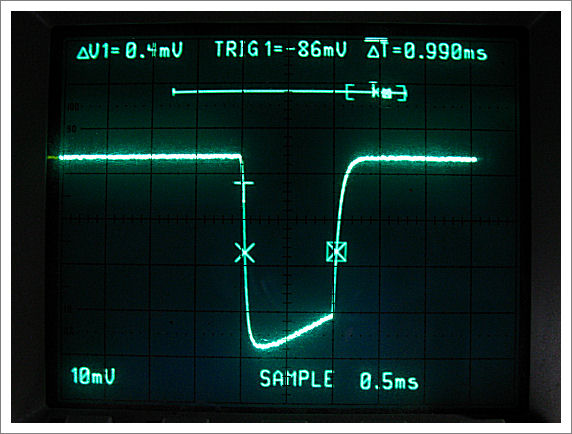
This is a flash at 1/2 power from a Speedlite 550EX. The duration of the flash is shown in the upper right of the trace - 0.990 milliseconds (1/1010s)
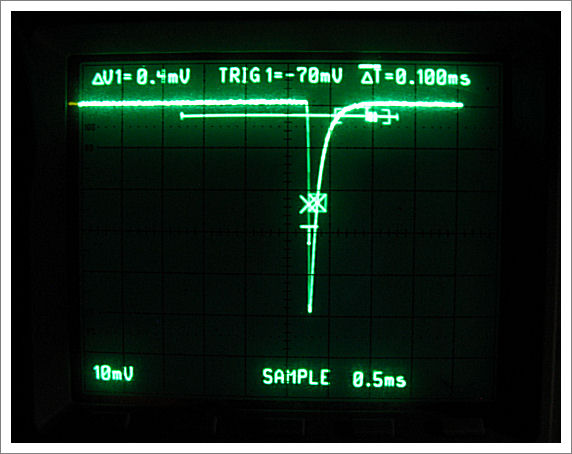
This is a flash at 1/128 power from a Speedlite 550EX. Note the much shorter duration then the 1/2 power flash. In this case the duration in 0.1 milliseconds (1/10000s)
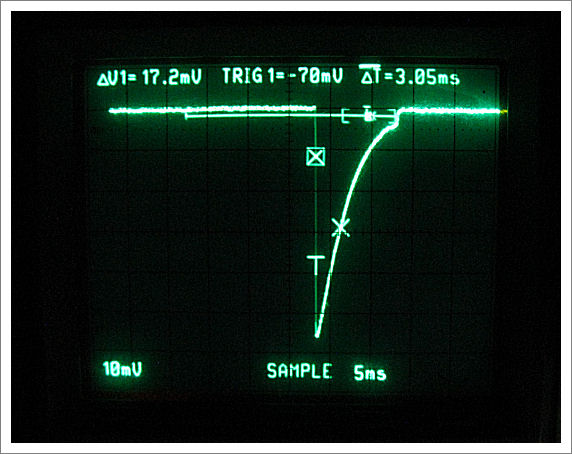
A full power flash in normal sync mode is a little messy. It's long, but intensity varies with time.
High-Speed Sync flash duration as a function of flash power
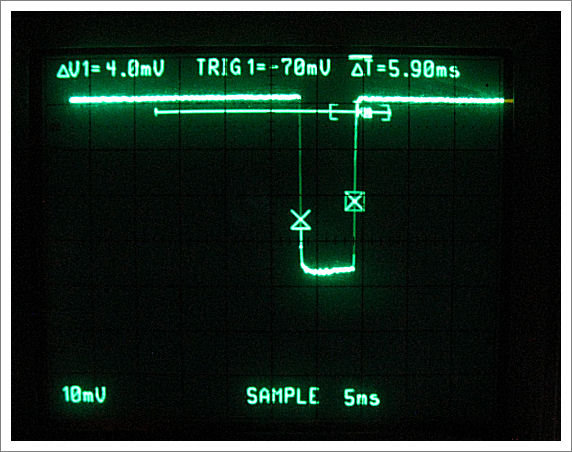
This is the time signature of a full power (1/1) flash, but this time with the 550EX speedlite set in high-speed sync mode. Note the time axis scale here is 10x that used for the normal flash traces. In this case the flash duration is 5.9 milliseconds (1/170s)(
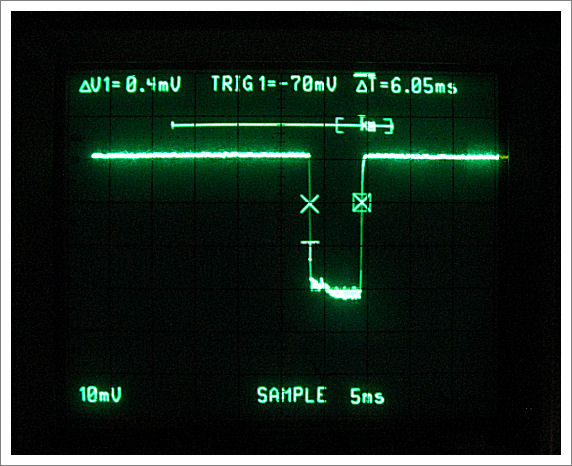
Here is the time signature nature of a 1/128 power flash with the 550EX set to high-speed sync. The flash duration measures 6.05 milliseconds (1/165s)), virtually the same as the full power flash duration in high-speed sync mode.
What does all this mean?
Here's the data we can gather from above:
- 1/2 power, normal sync, flash duration 0.99ms (1/1010s)
- 1/128 power, normal sync, flash duration 0.1ms (1/10000s)
- 1/1 power, high-speed sync, flash duration 5.9ms (1/170s)
- 1/128 power, high-speed sync, flash duration 6.05ms (1/165s)
The two important things that this data shows are:
- In NORMAL sysc mode, the duration of the flash pulse varies a lot with flash power, but it's always very fast, from 1/10000s at 1/128 power to 1/1010s at 1/2 power. At full power the flash is longer but changes rapidly with time. At the 1/2 power point, flash duration is around 1/350s.
- In HIGH-SPEED sync mode, flash duration is pretty much independent of power and is around 6ms (1/160s) or so. This is long enough to illuminate the whole frame when a slit moves across it in 5ms (1/200s)
Note also that in NORMAL sync, the flash duration is shorter than the camera sync speed (typically 1/200s), while in high-SPEED sync mode, the flash duration is longer than the camera sync speed. This leads to a very important point about differences in flash exposure between normal sync and high speed sync.
In normal sync mode the exposure is set by the power and duration of the flash. The shutter speed plays no part. The flash fires when the shutter is completely open and the whole film/sensor frame is exposed to light. You control exposure by aperture, ISO and flash power. Shutter speed plays no part (though it does, of course, affect the amount of ambient light that is recorded. So shutter speed can be used to control the ratio between the flash lighting and ambient lighting. The catch is, of course, that you can't go above a shutter speed of 1/200s or the flash will only illuminate the moving shutter slit over part of the frame.
On the other hand, in high-speed sync mode the flash acts as just like a regular light bulb (at least for about 6ms). In this case normal rules apply. Shutter speed DOES affect exposure, along with aperture, ISO setting and flash power. The only way you can affect the ratio between flash and ambient exposure is to change the flash power (or flash to subject distance).
The use of high-speed sync results in the effective illumination (guide number) or the flash dropping as shutter speed is increased. At very high shutter speeds (very narrow shutter slit widths) the total illumination from flash is greatly reduced (just as ambient light is greatly reduced by fast shutter speeds), which means that the flash range is correspondingly reduced. In addition the fact the flash has to produce multiple rapid pulses during h-speed sync operation also reduces output power. In fact the total output power of the flash in high-speed sync mode is only about 1/4 of the power in normal sync mode.
As an example, the 550EX has a guide number of 42 (meters at ISO 100) in normal sync mode at the 50mm zoom setting. In high-speed sync the guide number drops to under 30, even at 1/125s (which is slower than the sync speed). By the time you get to 1/8000s the guide number has drooped to 3.7 (m @ ISO 100). In case you're not familiar with guide numbers, the reach of the flash (maximum subject distance for full illumination) is given by [guide-number] divided by [aperture], so a guide number of 42 means you can shoot a subject 10.5 meters (34ft) away with a lens set to f4 and ISO set to 100. At 1/8000s in high-speed sync that distance drops to only 0.925m (about 3ft)
So you don't get something for nothing. You can shoot at any shutter speed with high-speed sync, even 1/8000s is fine, however you do reduce the range of the flash and you can no longer control ambient to flash lighting ratio with shutter speed.
When to use high-speed sync
High-speed sync is probably most useful for fill flash under bright and sunny conditions. If you're taking a portrait outdoors in bright sun, there can be a lot of contrast between areas of the face which are directly lit and the areas in the shadows cast by the nose, around the eyes and the side of the face away from the sun. If you want to use a large aperture to blur the background it's likely that your shutter speed will be faster than the cameras sync speed (around 1/200s). To fill in those shadows with flash and create a more pleasing portrait, high speed sync is required.
High speed sync can also be used to make your subject stand out from the background in an outdoor shot by using a fast shutter speed to underexpose the ambient lighting of the background and then using the flash in the high speed sync mode to add light to your subject. The only thing to be aware of here is the lower flash power in high speed sync mode and the fact that the higher shutter speed also cuts down on the flash illumination in high speed sync. This can mean you may not have enough power to illuminate your subject with a single high speed sync flash. In that case you either have to use multiple speedlites in high speed mode, or move your speedlite closer to your subject.
All current Canon EOS series Speedlites support a high-speed sync mode.
If you found this article useful, please tell others about it...
